De Beers Canada’s Victor Mine is nestled in the James Bay lowlands in the Attawapiskat watershed – part of the largest wetland on the planet. Victor Mine is the first and only diamond mine in Ontario with operations active from 2008 to 2019.
When the Ontario government gave De Beers the green light to mine for rough diamonds, it outlined conditions in its approval – one of them being that De Beers must report methylmercury and total mercury levels at its downstream monitoring stations.
De Beers Canada has a legal responsibility to accurately and fully report methylmercury and total mercury levels downstream from its mine. And this obligation continues despite the mine ceasing active operations in 2019.
Methylmercury is a toxin that bioaccumulates in the surrounding watershed and aquatic life, and can make its way up the food chain into humans. The reporting program was intended to act as an early warning system in case of heightened methylmercury levels downstream from the mine.
It emerged that De Beers had not reported information for five out of nine monitoring stations between 2009 and 2014, in violation of the terms of its permit. When the province failed to hold De Beers accountable for this unlawful failure to report, Ecojustice launched a private prosecution to hold the company accountable to the terms of its permit.
In 2021, after a long legal battle, De Beers pleaded guilty to one count of failing to report mercury monitoring data from the Victor Mine. As per the terms of the resolution, De Beers agreed to publicize all past and future annual mercury monitoring reports on its website. Additionally, the company agreed to pay a nominal fine of $100 and to make a $50,000 donation to charity.


